#fashion monographs
Explore tagged Tumblr posts
Text

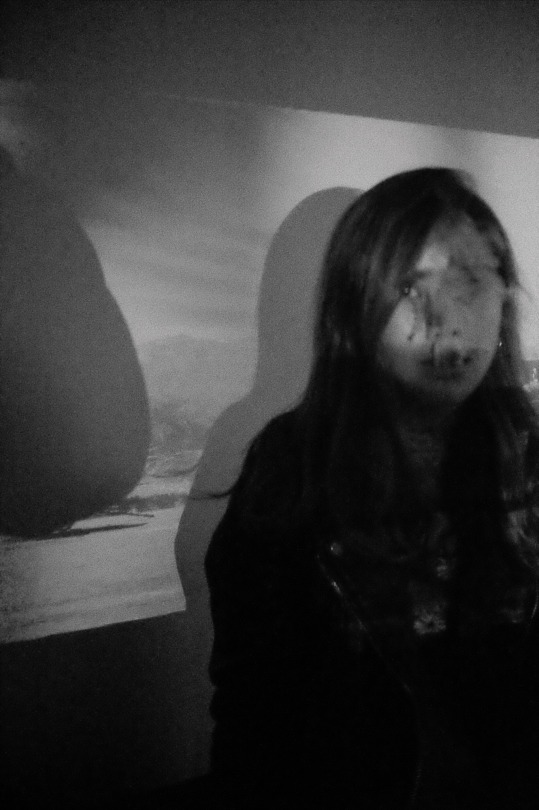
Leather jacket & cigarette drags
#me#leather#leather jacket#jacket#cigarrete#smoke#smoking#cigarettes#cigar#cigars#vape#vaping#ootd#fashion#asian#bnw#photography#black and white#monograph#kodak#film#aesthetic#aesthetics#travel#holiday#vacation#house party#resort#villa#hotel
15 notes
·
View notes
Text

Who was Lee Miller?
Why the model-turned-war photographer is finally getting her due
A surrealist with an incisive eye, finding the beauty and absurdity of everyday life. A model who posed for Vogue and sat for Pablo Picasso and Man Ray, but whose fashion career was suddenly cut short. A war photographer who embedded with the US military to chronicle the harrowing events of World War II — and posed defiantly in Hitler’s bathtub on the day of his death.
Lee Miller was an American artist who remade herself many times without straying from the principles that guided her life and career. When she died in 1977, her photographic work had largely been forgotten; her own family was unaware of the scope of her practice, and what she witnessed in the war, until they found her cache of negatives. Now, five decades later, she’s the subject of the Kate Winslet-led biopic “Lee,” which premiered at the Toronto International Film Festival in September, as well as a recent monograph of her work and an exhibition at mega-gallery Gagosian in New York, where some of her prints were for sale.
Her son, photographer Antony Penrose — whose father was the British surrealist painter Roland Penrose, whom Miller married in 1947 — has made it his life’s work to bring attention to his mother’s legacy. He co-directs her archive with his daughter, Ami Bouhassane, and has authored multiple books about Miller, including the most recent, “Lee Miller: Photographs.” For the past decade, he’s consulted on “Lee” as it came together, and has finally begun its run in both the United Kingdom and Spain.
“There were movies proposed and very nearly made before,” Penrose said. “This is the one that we’ve been waiting for, because I feel it is a brilliant rendition of Lee’s life, values and personality.”
He still recalls how “bewildering” it was when he and his late wife, Suzanna, found some 60,000 of her negatives and prints in their attic shortly after Miller’s death. She had developed a unique surrealist way of looking at the world, capturing everyday eccentricities that play with the viewer’s perception: a scratched-up door at a jewelry store becomes a small explosion of sparks; tar spilled on the street glistens darkly like some deep-sea or cave-bound creature.
But her range was staggering. Here was Elsa Schiaparelli supine among two cheetah sculptures, and Marlene Dietrich posing in dramatic sun in the designer’s ruched house coat. Here was a crowd of people spitting on four women, their heads shaved, as they went to trial for accusations of associating with Nazis. Here were the bodies of concentration camp victims in Dachau, and the liberated prisoners standing over a pile of human bones.
“None of us — and that includes my father — knew the scope of Lee’s work, particularly her war work,” Penrose said of his mother. “She deliberately didn’t tell him what was going on, because she didn’t want him to be worried.”
After the war, Miller struggled with depression and alcohol dependency, decades before post-traumatic stress disorder — and its symptoms — was officially recognized. When the occasional curator or art historian would turn up to better understand the depth of her work, Penrose said Miller would deflect the focus and downplay her career. It’s only been through her archive that he was able to understand the life she lived.
“It was a voyage of discovery,” Penrose added. “It was like finding a person that we had not known before — way beyond our kind of understanding and knowledge.”
Reinventing herself
For many years, Miller was remembered primarily for her modeling work in New York and with the reductive label of “muse” during her time in Paris. She sat for Pablo Picasso as he painted her in lurid yellow and green, illustrating her “extraordinary wit and liveliness… and a very bold, confrontational approach to life,” according to Jason Ysenburg, a director at Gagosian and co-curator of the gallery’s show “Lee Miller and Friends”.
She was also often remembered — but not credited — for her portrait collaborations with Man Ray, with whom she was romantically involved and remained friends throughout her life.
“Those images of Lee were as much by Lee as by Man Ray,” added Richard Calvocoressi, the show’s other co-curator.
Miller has been described by many as a supermodel on the cusp in her early twenties, a period just before she met Man Ray. But she was seemingly blacklisted by fashion clients overnight, after a portrait of her by the photographer Edward Steichen was licensed for a Kotex ad promoting menstrual products.
“She absolutely came to a crash stop. Nobody wanted the Kotex girl modeling their frocks,” Penrose said. “She didn’t even know that the photograph was going to be used for that purpose — it was bought through an agency.”
Though Miller used the setback as a sign to shift her practice, sexist social structures continued to shape her career. Art historians and curators of the 20th century relegated female surrealists — many of whom appear in Miller’s images, like the painter Leonora Carrington and the photographer Dora Maar — to the sidelines of the movement when they were, in actuality, crucial figures; Penrose recalls that his own father referred to them more as “muses” than artists in their own right, despite their prolific outputs.
But despite the imbalances within their group, Miller’s time with her friends ahead of World War II was seemingly idyllic. She’d left Paris in 1932 for New York when her relationship with Man Ray ended, and then unexpectedly married Egyptian businessman Aziz Eloui Bey and moved to Cairo. When she spent the summer of 1937 back in Paris and met Roland, it sparked a two-year affair (and series of love letters when they were apart), that eventually resulted in the dissolution of her marriage.
Some of Miller’s emblematic images of the period show their vacations across the south of France from beach outings with Roland, Picasso and Maar and the model Ady Fidelin, to a picnic that has drawn comparisons to Édouard Manet’s famed painting “Le Déjeuner sur l’herbe” as a topless Fidelin is pictured alongside Man Ray, the poet Paul Éluard and artist Nusch Éluard.
But as Ysenburg points out, the tumult of the era had already begun — Nazism brewed in Germany and the Spanish Civil War broke out, prompting Picasso’s monumental and career-defining work “Guernica” which was painted the same year Miller returned to Paris.
“It was a community that in the sense that they were friends and lovers,” Ysenburg explained. “It seemed a very carefree time for them in a world that was changing very quickly.”
She saw ‘what we’re missing’
Many artists fled Europe in the 1940s, and Miller could have gone back to New York to safety, Penrose said. But she’d settled down with Roland in London and refused to leave, instead becoming a photojournalist for British Vogue, documenting women who were contributing to the war efforts, and taking both fashion and street images during the Blitz.
Later, she was accredited as an official correspondent with the US armed forces — one of just four such female photographers. During this period, in Normandy and in Munich she worked closely with the Life photojournalist David E. Scherman. Together, they entered Hitler’s apartment with soldiers on April 30, 1945, the same day that Hitler shot himself in his bunker in Berlin. Just that morning, Miller and Scherman had taken photographs in Dachau; Miller tracked mud from the concentration camp all over the apartment’s floor before stripping down to pose in the bathtub. She took the same photo of Scherman, who was Jewish, as well.
“Those boots carried her that morning around the concentration camp, and now she’s grinding the filth of that place into Hitler’s nice clean bathroom,” Penrose said. “They prove that she’s not there as a guest in his house. She’s a victor.”
Even as Miller faced the harrowing effects of the war across Europe — sights that would take a toll on her in its aftermath — she still maintained her keen artist’s eye. After all, she believed there was nothing “more surrealist, more mad, more nightmarish” than the war, according to Calvocoressi.
“Even in the most dangerous and demanding circumstances, she’s still looking out for weird, quirky images,” Penrose said. “I find that that so endearing — the hallmark of her artistry is just to see what we’re missing.”
Miller took her last assignment for Vogue in the early 1950s, as Penrose notes that she could no longer meet deadlines because of her declining mental health. But she didn’t stop photographing, taking some 1,000 photographs of Picasso as Roland worked on his biography, which published in 1958.
Penrose said that throughout the course of her career, she was always “looking for the metaphor” in her surroundings. Of the many poetic moments she captured, one took place in front of the Vienna Opera House in Austria’s capital in late 1945 amid the lingering destruction of war. Framed by twisted metal support beams and rubble, the soprano Irmgard Seefried is photographed singing an aria from the Italian opera “Madame Butterfly,” in what Penrose believes to be an image set up by Miller — who captured her with arms outstretched, completely in silhouette.
“In a way, it’s a reversal, because you would have expected the singer to be beautifully lit from all kinds of sources.” Penrose explained.
“Gone is the costume. gone is any kind of glamorization… what we have is this absolute passion, about the triumph of art over destruction.”
Daily inspiration. Discover more photos at Just for Books…?
99 notes
·
View notes
Text
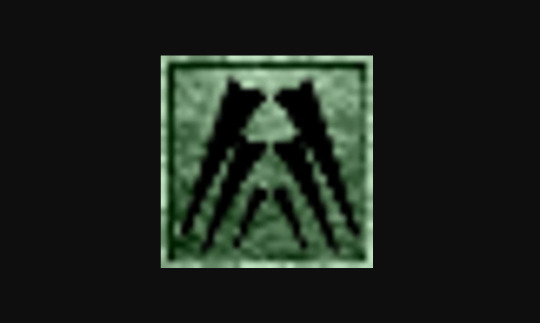
A word on Constant Effect Enchantments
We've had occasion before now to reflect how constant Illusion enchantments are detrimental to one's mental health. @theseventhoffrostfall has aptly dubbed it "the dunmer version of lead-based makeup" which also underscores how it became a kind of fashion statement, to cloak oneself in, say, cumulative Chameleon enchantments, in civil setting. The harmful effects of illusion magic ranges from insidious to truly devastating: as is the case with Sanctuary spell, shown to be the main driver of disassociative disorders—conditions that involve experiencing a loss of connection between thoughts, memories, feelings, surroundings, behavior and identity. Under these circumstances, one can imagine how even the lowliest Light spell—if made into a constant effect—would be further exasperating these symptoms.
Here I refer you to my monograph: "On pathology of indirect Light spells", Black Horse Courier Press, Imperial city.
While Reflect and Detect spells (of Mysticism school) may work towards eroding one's circumspection—the ethereality, the ghostliness of Sanctuary is an assault on faculties most fundamental.
So once again I ask you to call upon your local Council-members to vote on banning this magical mal-practice!
#elder scrolls#morrowind#tamriel#vvardenfell#morrowind lore#skyrim#oblivion#tesblr#tes lore#tes online#morrowind memes#magic#wizard#enchantment#sorcery#mage#mage class#gaming#spell#fantasy#spellcasting#tes 3 morrowind#enchanting#skyrim memes#elder scrols online#wizard problems#evil wizard#magic lore
53 notes
·
View notes
Text
"The idea of mothering and procreation morphed into Gorky’s fascination with prisoner transformation and perekovka. The labor camp would be the mother of a new working class. Both god-building and the maternal impulse dovetailed with the author’s largest philosophical and intellectual preoccupation: human fashioning. Whether it was the literal, biological creation of the human by the maternal womb or the transformation afforded by a personal journey or individual greatness, Gorky remained intrigued by the individual’s ability for creation, journey, and self-discovery. Maintaining that humans were inherently malleable and eternally improvable, he believed in the potential for endless refinement through diligent effort.
Gorky’s special relationship to the Belomor project allows for an understanding of his career as a symbolic representation of the ideals promoted at the camp. Gorky was a staunch enthusiast of prisoner labor and even predicted the possibility of a waterway similar to Belomor in his early works; in the April 1917 issue of his journal New Life (Novaia zhizn’) he writes
Imagine, for example, that in the interest of the development of industry, we build the Riga-Kherson canal to connect the Baltic Sea with the Black Sea […] and so instead of sending a million people to their deaths, we send a part of them to work on what is necessary for the country and its people.
Gorky’s condoning of Gulag camps such as Solovki and Belomor seems paradoxical to many scholars in light of his humanitarian endeavors, and some speculate either that Gorky was ignorant of the full extent of Stalin’s butchery or that he was aware, but was in a position that necessitated acquiescence to safeguard his well-being. When viewed in the context of his philosophical outlook on literature and labor, however, his support of prison camps seems not like an aberration but rather a natural extension of his belief in violent re-birth, a belief related to Marxist-Leninist ideology and the concept of god-building. Gorky sees people and language alike in the framework of craftsmanship. Perhaps his mistake was not so much his general support of Gulag projects, but his belief that human flesh can be formed like words on a page or cement in a factory. Gorky, after all, cared more about the craft than people themselves; in his 1928 essay “On How I Learned to Write” (O tom, kak ia uchilsia pisat’), he claimed that “the history of human labor and creation is far more interesting and meaningful than the history of mankind.” Gorky was key to the canal project because his philosophical interests exemplify the very core of Belomor: the violent transformation of people through creative acts.
Technology’s magic demonstrated humans’ usurpation of God in a tangible way, with the ever-widening capacity to harness and transform the natural environment showcasing the potential of man-made machines. Soviet pilots were imagined as literal incarnations of the New Man, and the massive expansion of the Soviet aviation industry in the mid 1920s provided some of the most concrete evidence of human superiority over the divine. Short voyages known as “air baptisms” (vozdushnye kreshcheniia) supposedly eradicated peasants’ belief in God while highlighting the majesty of Red aviation. In such “agit-flights,” pilots would take Orthodox believers into the skies and show them that they held no celestial beings. Those who participated in the flights would narrate their experiences to neighboring villagers, describing “what lies beyond the darkened clouds.” This phrase served as the title of a 1925 essay by Viktor Shklovskii in which a village elder embarks upon a conversional agit-flight that he later recounts to his fellow peasants. Six years later, Shklovskii participated in the writers’ collective that coauthored the now infamous monograph History of the Construction of the White Sea-Baltic Canal, in which a different, often deadly, type of technological program offered the promise of conversion. In both instances, darkness will be overcome by the enlightening potential of socialist rationalism: aviation will liberate the peasants from their ignorant beliefs, just as labor will supposedly bring the Belomor prisoners to the light of Soviet ideology. Such endeavors occurred before the backdrop of a larger civilizing project, since both the rural reaches of peasant villages and the wild expanses of untouched Karelia necessitated modernization.
Yet could such projects ever be completed? Did the New Man really exist, and could his creation ever be achieved? The messianic vision of Soviet socialism necessitated that paradise lie always just out of reach.
Similarly, Nietzsche posits the development into the Übermensch as a perennially elusive goal; like the Faustian concept of striving, the individual is forever trying to perfect oneself without necessarily ever achieving perfection. This constant yearning renders the present as the future, as the purpose of today is necessarily the reward of tomorrow. In the Soviet Union, the regime assured people that the difficulties they endured were required in order to reach the svetloe budushchee (radiant future), a utopia found at the end of an interminable road. In the absence of an end result or final destination, the voyage itself becomes the site of cultural exploration."
- Julie Draskoczy, Belomor: Criminality and Creativity in Stalin’s Gulag. Boston: Academic Studies Press, 2014. p 30-32
#maxim gorky#new man#belomorkanal#belomor#gulag#white sea baltic canal#Беломо́рско-Балти́йский кана́л#prison camp#work camp#soviet history#soviet union#stalinism#academic quote#reading 2024#history of crime and punishment#perekovka#russian revolution#soviet communism
42 notes
·
View notes
Text
Every reference I could find to Sherlock's love of bees in Elementary, organized by episode number
season 1 episode 1:
Watson, walking onto the Brownstone's rooftop to find Sherlock and surprised to see beehives there next to him: "Um, did you know that honey was dripping through the ceiling?" Sherlock, sitting and looking at his beehives: "Yes. Happens sometimes." Watson: "I take it beekeeping is a hobby." Sherlock: "I'm writing a book. Practical Handbook of Bee Culture with Some Observations Upon the Segregation of the Queen. Up here. I've just started Chapter 19."
season 1 episode 5:
Sherlock, explaining how he knows someone: "We frequent the same beekeeping chat room. He has an impressive collection of Caucasians. Species of bee."
season 1 episode 7:
Watson: "There was a client back here a little while ago who was also interested in beekeeping." Edson: "Sure. You mean Sherlock."
season 1 episode 9:
*Sherlock is wearing a shirt with the writing “Bee 92” on it*
season 1 episode 12:
Sherlock: "Our six weeks together are very nearly up, Watson. In a matter of days, your room will be vacant. I'm very seriously considering turning it into one large apiary."
and
M, about Sherlock torturing him: "You figured out where you're gonna start yet?" Sherlock, looking over his table of torture devices that he brought that is shown to include a few beehives: "I have not. I had hoped to use the bees in some fashion, but then it occurred to me you might be allergic."
and
Sherlock: "Watson, what is it?" Watson: "I called your father last night. Given everything that's happened, I recommended staying on longer." Sherlock: "And?" Watson: "He agreed." Sherlock: "I suppose the apiary will have to wait."
season 1 episode 17:
Crabtree: "Delivery for you, Mr. Holmes." Sherlock: " Thank you, Crabtree, but I'm afraid I c… Oh, my God. Is that…?" Watson: "A bee in a box? Yes, it is. Fairly unimpressive as far as bribes go." Sherlock: "Not if you're an apiculturist. That's an Osmia avosetta. Solitary bee famed for building exquisite nests from flower petals. It's on the verge of extinction. Crabtree, this is exquisite. I cannot accept it. Please, tell Mr. Lydon not to contact me again."
and
[BEE BUZZING] Watson: "Hey, why do you have the box with the bee in it?" Sherlock: "We took Gerald Lydon's case." Watson: "We did?" Sherlock: "Well, frankly I couldn't say no to him. It would have felt like denying a dying man his last wish. We are taking this home, and then we are going to the genetics lab which confirmed his diagnosis."
and
Sherlock: "Close that door immediately!" Watson: "What's up? Sherlock: "I was examining the Osmia avosetta that Gerald Lydon gave me and it got loose." Watson: "Oh, so there's an almost-extinct bee flying around in here?" Sherlock: "Yes, and I would rather it didn't get out."
season 1 episode 19:
Miss Hudson, to Sherlock: "Oh, and I stacked your monographs that you wrote on your desk. I liked the one about queen bees."
season 1 episode 20:
Sherlock: "Another reason to dislike Milverton. He keeps cats." Watson, sarcastically: "Well, he should get himself a real pet, like a beehive." *Sherlock gives her a look*
and
[CELL PHONE RINGING] Sherlock, answering his phone: "Brownstone is on fire, my bees have escaped, and there is a giant comet headed for Manhattan." Watson: "Excuse me?" Sherlock: "The way the evening is going, I thought you could only be calling with more good news."
season 1 episode 21:
Sherlock: "What kind of an allergy requires a medical alert bracelet?" Watson: "Uh, anything that could bring on anaphylactic shock, certain foods, medicine, insect bites." Sherlock: " Exactly. A moment ago, I could have sworn I saw an Africanized honeybee." Watson: "How do you "Africanize" something?" Sherlock: "It's a term to describe a particularly aggressive species. It's odd to… Odd to see them here. They're not native to New York. It's almost as if someone has placed it here on a route known to be frequented by Hillary Taggart." Watson: "So you think he's planning a murder by bee?" Sherlock: "The hive will be facing southeast in dappled sunlight with minimal wind. And here they are, newly formed and flourishing. Oh, yes. And here is the food source. Someone's feeding them sugar water so they multiply even faster." Watson: "Well, it's pretty baroque way to kill someone, isn't it? I mean, cultivate bees, feed them, and then poke the hive with a stick every time Hillary Taggart runs by?" Sherlock: "Well, he might be planning to swipe her with lemongrass oil beforehand, make sure they're attracted to her. It's actually quite a tidy plan. You know, she flees, bees sting-- tragic accident." Watson: "If she's that allergic to bee stings, then she's gonna have an EpiPen." Sherlock: "Well, an EpiPen would work against one or two stings, but how effective is it gonna be against an army of bee assassins?" Watson: "If the man we are looking for is feeding these bees, he's gonna have to come here eventually." Sherlock: "Yeah. Quite soon, I'd imagine, 'cause the sugar water's getting low." Watson: "Ugh, great. So we get to stake out a hive of killer bees."
season 1 episode 24:
[Watson walks onto the brownstone's rooftop to find Sherlock sitting and looking at his beehives with a magnifying glass] Sherlock: "Do you remember the rare bee I was given for proving that Gerald Lydon had been poisoned?" Watson: "The bee in the box, sure." Sherlock: "Osmia avoseta is its own species, which means it should not be able to reproduce with other kinds of bees. And yet, nature is infinitely wily." Watson: "So box bee got another bee pregnant?" Sherlock: "Quite so. Which means, they should be reclassified as an entirely new species. First newborn of which… is about to crawl its way into sunlight." Watson: "Oh, my God." Sherlock: "As the discoverer of the species, the privilege of naming the creatures falls to me. Allow me to introduce you to Euglassa Watsonia." Watson, surprised and then touched: You named a bee after me? You named a bee after me." Sherlock: "Should be dozens more within the hour. If you'd like, I could come and get you once they're all here. Watson: "That's all right. I think I'll just watch."
season 2 episode 12:
[sherlock is shown taking a box out of his beehive]
and
Watson: "You didn't show me these letters. You hid them in a beehive."
and
[sherlock is shown taking the box back into his beehive]
season 3 episode 10:
Barbara: "Barbara Conway. I'm senior vice president of…" Sherlock: "Senior vice president of AgriNext's GMO research division. Quite the corporate monstrosity, AgriNext, hmm? In addition to your dominance in agricultural industries, there is powerful evidence to suggest that your neonicotinoid insecticides are the culprits in the ongoing bee genocide known as colony collapse disorder. Would you care to comment on that?" Barbara: "When you told my assistant you had some questions, was that just a lie to get in and harass me?" Sherlock: "Ms. Conway, are you familiar with the name Clay Dubrovensky?" Barbara: "No." Sherlock: "What about the Wutai Pingtung orchid?" Barbara: "I'm sorry. What?" Sherlock: "You are very good at feigning innocence. Perhaps it's all that lying about the bees."
season 3 episode 11:
Watson: "Can you imagine how she feels when she looks at it?" Sherlock: "I have done. Repeatedly. My name is Sherlock, and I have allowed empathetic thoughts to clutter my mind and reduce the clarity of my perception." Watson: "So you called in the bees to crowd out caring." Sherlock: "To no avail."
season 3 episode 14:
Mr. Joseph: "Mr. Holmes, thank you for agreeing to see me. We've actually met before-- sort of." Sherlock: "You're BeeBeeKing17." Mr. Joseph: "I am. (chuckles) You're a detective. I know from your posts. I have a bit of a problem…" Sherlock: "I'm gonna stop you right there, Mr. Joseph. I can't help you." Mr. Joseph: "You don't know what I'm asking." Sherlock: "I don't need to. In the four years I've frequented your Web site, I've sent you no fewer than 13 letters detailing my proposed solutions to the phenomenon known as colony collapse disorder. You have sent me exactly zero replies." Mr. Joseph: "You know how much correspondence I get?" Sherlock: "I've got no idea. I do know, however, that mine is backed by quality thinking. If you'd bothered to find that out, you wouldn't find yourself without a detective in your hour of need." Mr. Joseph: "Is there some way that I can make this up to you?" Sherlock: "I suppose, if you were to publish my theories on gamma rays as a potential solution to CCD, then I might be able to hear you out." Mr. Joseph: "Gamma rays? They… they've worked in a couple instances, but they… they don't scale as an answer. They're too dangerous. You give John Q. Beekeeper access to gamma rays, he'll melt his face off." Sherlock: "A fact I addressed in my most recent letter." Mr. Joseph: "Fine. Yeah, I'll put it on the site." Sherlock: "I also require that you change your online user name. The cheap punnery of "BeeBeeKing17" is offensive to musicians and apiarists alike. You'll make the change?" Mr. Joseph: "I guess." Sherlock: "Good. So what seems to be the problem?"
season 3 episode 20:
Sherlock (on the other line of the phone): "Watson, you still over there?" Watson: "Yes, I'm still here, because I can't go home, because of you. Why did you bring the bees in the house anyway?" Sherlock, shown to be standing in their kitchen while wearing his beekeeper suit and surrounded by bees: "Varroa mites are a pernicious threat to the colony. I intended a thorough inspection, as well as an application of baker's sugar as a preventative measure. My thoughts were concerned with colony collapse. I failed to see the more urgent threat of table collapse." Watson: "Wait a second. You're not talking about my table, are you? The one that I bought for my apartment?" Sherlock: "Two hours should be sufficient to return the hive to stasis. I'll be in touch."
season 3 episode 23 (the entire episode but especially):
Unnamed cop: "If you guys work for the USDA, why didn't you just say so?" Watson: "We don't. My partner's on a beekeeping message board with a few of their researchers. They asked us to come and have a look, since it's one of their colleagues that died."
and
Sherlock: "You might want to tell your colleague that the apiarist is not a strong suspect. Unnamed cop: "The hell she isn't. She was the only other person out here when this thing happened." Sherlock: " And as far as Watson and I have been able to discern, utterly devoid of any motive-- unlike the soulless corporate golem that is AgriNext." Unnamed cop: "You think a company did this?" Sherlock: "It wouldn't be the first time they'd harbored a killer." Watson: "He's right-- we found one there a few months ago. So what makes you think they did this?" Sherlock: "Elevated levels of Colony Collapse Disorder along the Northeast." Watson: "You putting that on AgriNext, too?" Sherlock: "Everett Keck did. His notes strongly suggest that the company's neonicotinoid pesticides are the cause." Unnamed cop: "So this guy was killed over some dead bees?" Sherlock: "A hundred million dead bees. The regional numbers are so anomalous that an international apiary summit has been convened at Garrison University to discuss the problem this week. Everett Keck's notes suggest he was willing to cut short that debate and lay the blame squarely at the feet of AgriNext."
and
Watson: "Oh… Looks like you opened up a satellite office for the Department of Agriculture in here." Sherlock: "25,000 species of bee-- always much to learn." Watson: "Well, if you're planning on picking up where Keck left off, it might be nice to solve his murder first."
and
Watson: "So you think that Keck tried to kill his boss to cover up poisoning a few bee hives?" Sherlock: "More than a few. I've come to believe that Everett Keck was not just studying Colony Collapse Disorder. Everett Keck was Colony Collapse Disorder incarnate. You might recall my recent concern over varroas in my own hives. These fears were born out of rumblings on BeeCircuit.com. Most of the talk on the spike of this season's colony death rate centered around the spread of deadly mites." Watson: "Okay, but I thought Keck was gonna prove it was pesticides. Sherlock: "That's what his note suggested. That's what he intended to report, but the data suggests that the parasites were appearing in greater than expected numbers everywhere he went." Watson: "You did all this overnight? Sherlock: "You know I outsource arithmetic to Harlan. Okay, so, that's Keck. And there are three other ASI researchers. He found more mites than the others. Many more. According to Harlan, the variance between Keck and his colleagues cannot be explained away by known confounds. The odds that Mr. Keck was not actively spreading varroa mites everywhere he went approaches one in 29,000." Watson: "So, there isn't a spike in Colony Collapse Disorder after all." Sherlock: "Every dead hive is a tragedy. But outside of one nefarious USDA field researcher, no, the CCD baseline would not be inflated at all." Watson: "Why would he do something like this?" Sherlock: "I don't know. I'm fairly certain, however, he had help. The heart attack that almost killed Calvin Barnes occurred whilst Mr. Keck was doing his rounds in Connecticut." Watson: "He had a partner." Sherlock: "We've solved one murder. Now we just have the remaining 100 million."
and
Tara Parker: "No. No way. You can't just write off a global issue because one guy went on a bee-killing spree." Sherlock: "I share your concerns about Colony Collapse Disorder writ large, I do. I have hives of my own. But your degree is in entomology, and, uh, the mathematicians have spoken."
and
Sherlock, excitingly surprised: "His Highness Sheik Nasser Al-Fayed is making an appearance?" Tara Parker: "Supposedly." Sherlock, explaining to Watson: "Nasser is an emir. He's a member of the royal family of Al Qasr in the United Arab Emirates. He's a black sheep. He's not trusted with state business, like his brothers." Griffin Parker, to which Sherlock is shown nodding in approvement: "He's also got the most expensive apiary on the planet. State-of-the-art hives." Sherlock: "He's a recluse. Rumors on BeeCircuit.com are that he never leaves his family's estate." Griffin Parker: "Well, I wouldn't, either. He has almost 1,000 species."
and
Sherlock: "I'm friendly with the moderator of BeeCircuit.com. You deleted your private messages, but he was able to dredge these off the server."
and
Sherlock: "You got away with kidnapping the sheik. You won't get away with what you did to Calvin Barnes. Or millions of bees."
season 4 episode 13:
Trent Garby: "I moved out because of you two. I couldn't take it anymore. The weird noises, the strange smells, the explosions, and the damn bees on the roof."
and
Watson: "Robert Frost said that fences make good neighbors. But maybe that's because there wasn't sound-dampening insulation back then. Since you are rebuilding anyway, we can have it installed for you as a belated housewarming gift. So a quieter home for you, and a neighbor who knows what he's getting into for us." Trent Garby: "You don't even know me." Watson: "We'd like to." Trent Garby: "All right. When I get the insurance settlement, I'll let you know." Watson, giving him a jar of honey: "This is from Sherlock. He wants you to know that bees can be good neighbors, too."
season 4 episode 23:
Bell: "We think he crossed with Krasnov, who was there to steal a barrel of pesticide. There's one missing." Watson: "Clothianidin is used to treat corn crops. I've heard Sherlock rail against the stuff. It's bad for bees. But it is good for explosives."
season 4 episode 24:
Morland, looking at Sherlock's hives: "They stay here even during winter, do they not?" Sherlock: "Excuse me?" Morland: " The bees. This is their home… rain or shine." Sherlock: "Yes, let's talk about bees, instead of the execution you just carried out in Yonkers."
season 5 episode 21:
Sherlock: "You might not know what Mr. Leroux looks like, but I assure you, those photographs of you showing my friend around will have the FBI and Interpol swarming your property like bees."
season 6 episode 8:
Kelsey: "I'm sorry if that sounds judgmental, but… judging you is kind of the whole point of this trip." Watson: "It's okay. I mean, you have to go through your process, right?" Kelsey: "Am I crazy, or did I see a bunch of beehives on your roof?"
season 6 episode 17:
Watson: "He named an inchworm after her?" Sherlock: "It’s not uncommon for scientists to name species after people they care for or admire. I named a honeybee after you. But I, of course, was honoring my work partner."
season 6 episode 18:
Sherlock: "We need to talk about what happens after I die." [cut to them now in the kitchen, with Watson holding a pile of pages] Watson, reading the title: "“The Last Will and Testament of Sherlock Holmes”?" Sherlock: "According to Mr. Horowitz, in three days' time, I am to be riddled with bullets by an unknown assailant in an unnamed part of the city. While I doubt that will happen, reading it did remind me that you should have a copy of the appropriate paperwork to ensure a smooth probate." Watson: "You didn't write all this up today." Sherlock: "No, I wrote it several years ago when we formalized our partnership. I just didn't give you a copy." Watson: "Am I reading this right? You left me everything?" Sherlock: "You're surprised?" Watson: "Uh… I guess I'm touched. Sherlock: " There are some directives in the back that you should review. Watson: "Instructions on what to do with your cerebellum? Sherlock: "Mmm. Also my bees. They will need a proper home."
season 6 episode 21:
Sherlock, walking into the room to find Watson filming a close video of his bees while playing a loud song: "Something I should know?" Watson: "Everyone got back to us while you were out. They said they would look into Agent Mallick if I gave them an up-close view of one of your beehives and put this song on repeat. I mean, I had to get movers to get it down here, but at least we did not have to humiliate ourselves this time." Sherlock: "Oh, you've been humiliated. You just don't realize it. One of the founding fathers of Everyone, StingSquat, is an admitted melissophiliac. He's aroused by bees. You just arranged a sex show with a cast of thousands."
season 7 episode 13:
Sherlock, sounding touched, after seeing that his hives are still in the brownstone after his years away: "You kept the bees." Watson: "I thought Arthur might find them interesting. Plus, the free honey.
#dude really loves his bees huh#cbs elementary#elementary#elementary tv#elementasquee#sherlock holmes#elementary sherlock#holmes and watson#sherlock and watson#sherlock and joan#joan watson#jlm#johnny lee miller#lucy liu#kitty winter#you named a bee after me#he named a bee after her#bees#save the bees
102 notes
·
View notes
Text
















Issey Miyake East Meets West
Kazuko Koike, Art Dir.Ikko Tanaka
Heibonsha Publ., Tokyo 1978 reprint 1984, 215 pages, 25x36,5cm, ISBN 0072-820012-7800
euro 180,00
email if you want to buy [email protected]
Issey Miyake is one of the most well known Japanese designer names in history, his designs taking the world by storm from as early as the 1970s. Miyake made many outfits for ballets and dance performances and then began to use many dancers to model the clothing. The designer often studied the movements of the dancers as they were wearing his clothing as he was fascinated by the way the fabrics would swing around or hang down. This approach to clothing, combined with Japanese sensibilities, resulted in Miyake’s colossal impact in the fashion industry alongside the likes of Rei Kawakubo of Comme des Garcons and Yohji Yamamoto of his eponymous label. However, despite having made such an impact many have not been able to truly grasp Miyake’s influence during these early years, until now.
The book, Issey Miyake: East Meets West, came out in 1978 and features an impressive contrast of designs influenced by both Eastern and Western cultures. East Meets West was the first ever monograph that was created about the living fashion designer, and its importance is unquestionable. With over 200 pages of full bleed color images featuring some of Issey Miyake’s colorful clothing, the book truthfully depicts the designer’s passion for design, culture, and authenticity. From editorial photos shot by the likes of Noriaki Yokosuka (as covered in our previous post), to the capturing of runway spectacles that combine movement with clothing, it goes without saying that East Meets West immerses you into the fantastic world of Issey Miyake.
17/10/24
13 notes
·
View notes
Photo


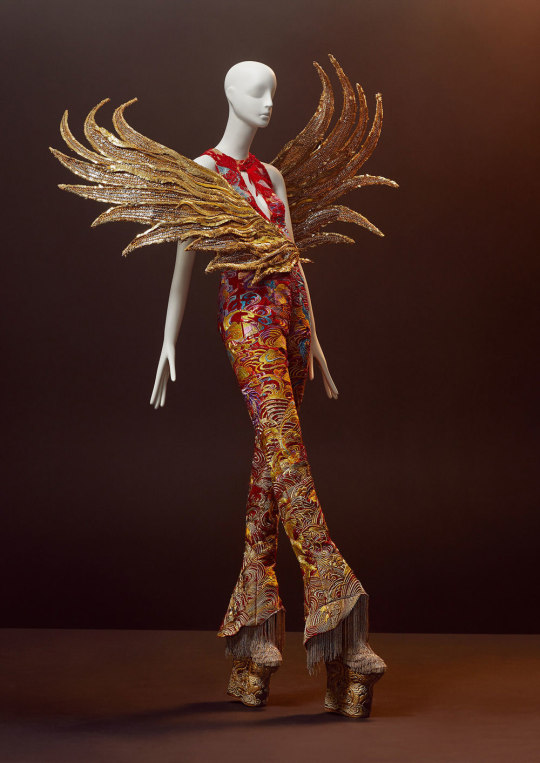


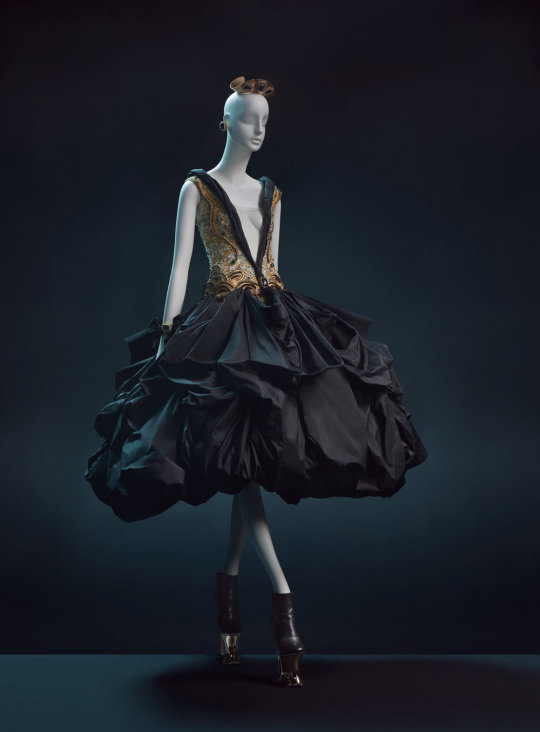

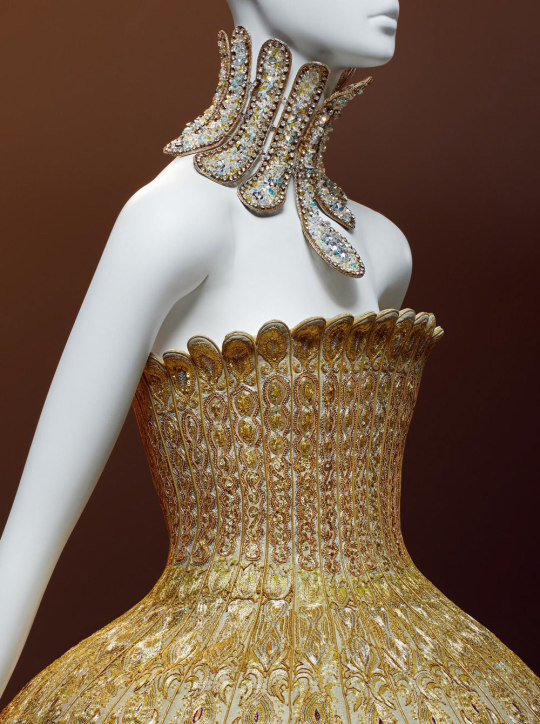


Guo Pei - Couture Beyond
Photography - HOWL Collective Creative Direction & Retouch - Jim Lind
The first major book on China’s leading couture visionary reveals the intricate craftsmanship and imperial glamour that has fashion publications worldwide declaring Guo Pei’s creations 'the Empire’s new clothes.' An exponent of artisan craftsmanship and theatrical fantasy often compared to Alexander McQueen and Sarah Burton, Guo Pei dresses Chinese state dignitaries and American celebrities alike in richly bejeweled creations of imperial opulence. The designer’s first monograph, published on the occasion of her first solo exhibition, offers insight into the growing global influence of China and the complexities of its cultural transition.
(via Guo Pei - Couture Beyond :: Behance)
26 notes
·
View notes
Text
Not everything is or was Sasha/No todo es o fue Sasha: Bettie Page.
On my to-do list, one day we have to talk about Betty Page. Some spiteful people accuse me of being obsessed with the blog because it is my priority here (and not him, who just appeared out of nowhere) and especially with Sasha Grey, but apart from the aspirational (and not sexual) implications that the polymath actress has for me; it seems to me that in makeup, fashion, physique and training she is absolutely representative of the beginning of the 21st century (and it was time to praise a woman with a high IQ instead of a bra size).

En mi lista de temas pendientes, un día tenemos que hablar de Betty Page. Algún despechado me acusa de estar obsesionada con el blog por tenerlo como prioridad estando aquí (y no él, que acaba de aparecer de la nada) y sobre todo con Sasha Grey, pero aparte de las implicaciones aspiracionales (y no sexuales) que para mi la actriz polímata tiene; me parece que en makeup, fashion, físico y formación es absolutamente representativa del comienzo del SXXI (y ya iba siendo hora de encumbrar a una mujer con alto IQ en vez de talla de bra).
But there have been more eras in the world, and about the middle of the 20th century the Grey of the past is Betty Page: her physique was not perfect to be a pin up before the invention of porn as we know it, but her charisma and the fact that she went around doing commissions within tastes before niche (bondage, spanking… today even naiff, then almost Martian) made her stand out and be remembered for decades… Does that profile sound familiar to you? I would like to do more research and write a short journalistic piece on the subject. I'll see when I can do it, because I want to read monographs on the subject.
Pero ha habido más épocas en el mundo, y sobre la mitad del SXX la Grey del pasado es Betty Page: su físico tampoco era el perfecto para ser pin up antes de inventarse el porno que conocemos, pero su carisma y el que anduvo haciendo encargos dentro de gustos antes de nicho (bondage, spanking… hoy hasta naiff, entonces casi marciano) le hicieron destacar y ser recordada durante décadas… ¿Les suena ese perfil? Me gustaría documentarme más y escribirles una pequeña pieza periodística sobre el asunto.. A ver cuando puedo hacerlo que quiero leerme monografías sobre el asunto…
#fotografia#photography#legs#sexy chick#stockings#medias#beauty#sexy pose#pin up#pin up girls#pin ups#pin up girl#bettie page#bettie mae page#betty page#adult industry#pornocultura esotérica#esoteric pornoculture
10 notes
·
View notes
Text
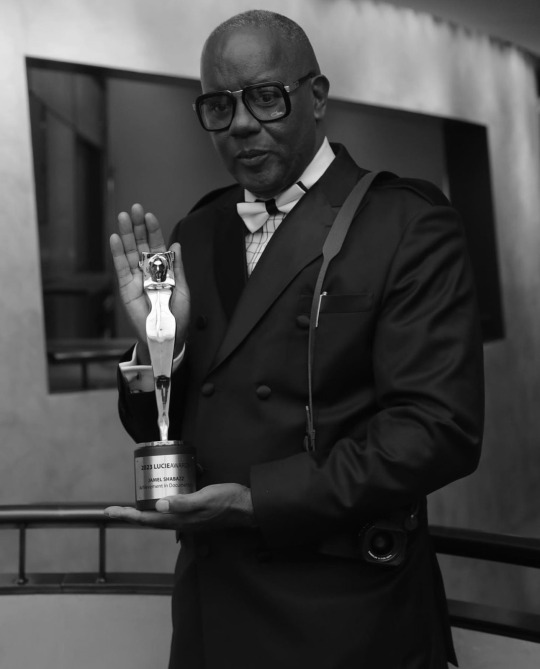


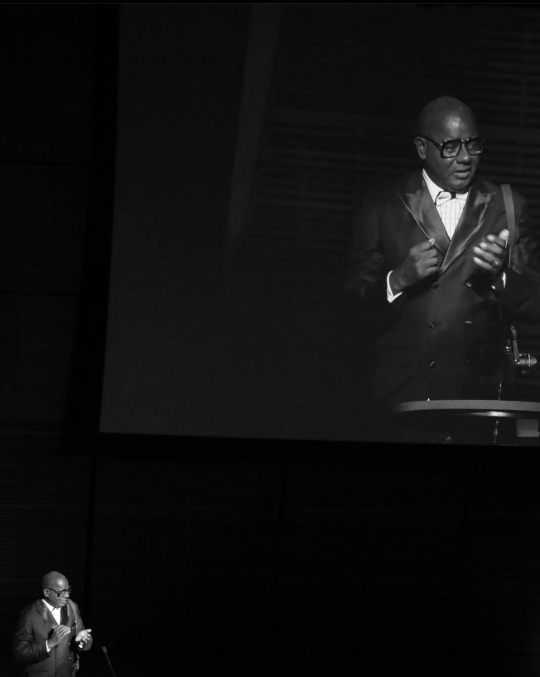
What an EPIC night, Brother Jamel Shabazz received the prestigious @luciefoundation Award presented by Peter Kunhardt, Jr. Executive Director for The Gordon Parks Foundation at Carnegie Hall… So well deserved.
Jamel Shabazz is best known for his iconic photographs of New York City during the 1980s. A documentary, fashion, and street photographer, he has authored 12 monographs and contributed to over three dozen other photography related books.
His photographs have been exhibited worldwide and his work is housed within the permanent collections of The Whitney Museum, The Brooklyn Museum, The Studio Museum in Harlem, The Smithsonian’s National Museum of African American History and Culture, The Fashion Institute of Technology, The Art Institute of Chicago and the Getty Museum.
Over the years, Shabazz has instructed young students at the Studio Museum in Harlem’s “Expanding the Walls” project, The Schomburg Center for Research in Black Culture “Teen Curator’s” program, and the Bronx Museum’s “Teen Council.” He is also the 2018 recipient of the Gordon Parks award for excellence in the arts and humanitarianism and the 2022 awardee of the Gordon Parks Foundation/Steidl book prize. His goal as an artist is to contribute to the preservation of world history and culture.
It is an honor to collaborate with Brother Jamel Shabazz on the @albeesquaremall book that has been years in the making.
Another one of Brooklyn’s Finest 👑🏆🫡 @jamelshabazz
CARTER™️ Magazine
#carter magazine#carter#historyandhiphop365#wherehistoryandhiphopmeet#history#cartermagazine#today in history#staywoke#blackhistory#blackhistorymonth#jamel shabazz
33 notes
·
View notes
Note
Congrats on your new journal article! Can you talk a little about your research? What’s your area of focus, what research plans do you have coming up? I have an insatiable interest in other peoples’ research!
I am a medievalist by training, though my focus has also expanded into early modernism and modernism, and one of my main research interests is how medievalism or medievally-themed ideas (for better and often uh, very much worse) operate in modern politics, culture, and media. My latest journal article is examining the premodern history and the culture of crusading in the current Russia-Ukraine war; the one that came out earlier in the year was premodern queer history and the crusades. I generally work on premodern (broadly defined) gender/queerness, law and society, war, crusades, religion, and politics, based in but by no means confined to Western Europe, with ancillary interests in the Mediterranean and Eastern Europe. As noted, I also have a strong comparative-historiography interest in demonstrating how medieval history is used to inform modern society and why this is often very misleading.
My current research focuses on premodern queer history, which has been the theme and/or co-theme of most of my more recent stuff. I am developing a mini-book project based on my UK conference paper from this summer focused on reconsidering queer legal, textual, narrative, and physical space within the premodern/medieval context. The general disclaimer is often that this material is marginalized, individualized, ignored, irrelevant, or existing unremarked on the fringes of medieval society, far from the centers of power, which frankly I don't think is correct. If you look at the places in which the theme and substance of "queerness" (in the modern definition; this is not the same at all in the medieval world) exists, it in fact directly informs and creates some of the most central institutions (and anxieties) of European-medieval society, including the king, the church, the literature, and other areas of traditionally-defined "power." So while the study of queer silence, gaps, omissions, and other places where the heteronormative record has prevailed is useful in some amount of retrieving unsignified queer experience, this also gives rise to the notion that premodern queerness is only ever silent or subtextual, and places where it very explicitly appears or speaks have to be argued over or discredited or somehow created to say something other than what they say. So yes.
Because my current university role is primarily administrative rather than teaching-focused, I don't have nearly as much time for actual research as I would like. I am in the process of developing the written prospectus for the above project; it will go to the editorial board at a medieval and renaissance studies center and university press when I am done. We don't know when that will be, but we certainly hope something like a timely fashion (I also have another full-length research project/monograph on premodern queer history that will probably have to wait for a faculty post with dedicated research time, assuming I ever get one. We will see.)
44 notes
·
View notes
Note
Found some books and articles that might help with your research. These come from the bibliographies of Craig Williams' book "Roman Homosexuality," and Kelly Olson's article "Masculinity, Appearance, and Sexuality: Dandies in Roman Antiquity." Good luck!
Olson, Kelly. Masculinity and Dress in Roman Antiquity. Routledge Monographs in Classical Studies, 2017.
Alexandra T. Groom, Roman Clothing and Fashion (Stroud, UK: Tempus, 2002), 31-73; Julia Heskel, "Cicero as Evidence for Attitudes to Dress in the Late Republic," in The World of Roman Costume, ed. Judith L. Sebesta and Larissa Bonfante.
Mary Harlow, "Clothes Maketh the Man: Power Dressing and Elite Masculinity in the Later Roman World," in Gender in the Early Medieval World: East and West., 300—900, ed. Leslie Brubakerand Julia M. H. Smith
Brisson, Luc. 2002. Sexual Ambivalence: Androgyny and Hermaphroditism in Graeco-Roman Antiquity. Translated by Janet Lloyd. Berkeley.
Foxhall, Lin, and John Salmon, eds. 1998a. When Men Were Men: Masculinity, Identity, and Power in Classical Antiquity. New York. Thinking Men: Masculinity and Its Self-representation in the Classical Tradition. New York.
Gilmore, David D. 1990. Manhood in the Making: Cultural Concepts of Masculinity.
Gleason, Maud W. 1990. “The Semiotics of Gender: Physiognomy and Self-fashioning in the Second Century C.E.” In Halperin, Winkler, and Zeitlin 1990: 398–415.
Gleason, Maud W. 1995. Making Men: Sophists and Self-presentation in Ancient Rome. Princeton.
Graver, Margaret. 1998. “The Manhandling of Maecenas: Senecan Abstractions of Masculinity.” American Journal of Philology 119: 607–32.
Gunderson, Erik. 2000. Staging Masculinity: The Rhetoric of Performance in the Roman World. Ann Arbor.
Kleijwegt, Marc. 1991. Ancient Youth: The Ambiguity of Youth and the Absence of Adolescence in Greco-Roman Society. Amsterdam.
Porter, James I., ed. 1999. Constructions of the Classical Body. Ann Arbor.
Walters, Jonathan. 1997. “Invading the Roman Body: Manliness and Impenetrability in Roman Thought.” In Hallett and Skinner 1997: 29–46.
Williams, Craig A. Roman Homosexuality: Ideologies of Masculinity in Classical Antiquity. Oxford.
Wyke, Maria, ed. 1999. Parchments of Gender: Deciphering the Body of Antiquity. Oxford.
YAYY thank you so much!! this is really useful!! my idea is mostly to do with ideas about attractiveness in terms of physical features as opposed to presentation, but as far as i know there's no writing on it yet so all of these are useful as sort of... nearby topics. it'll be really interesting to dig into the masculinity aspect of it as well as like... age/youth too
17 notes
·
View notes
Text


Still the most comprehensive study of Willem Dudok’s life and work is Herman van Bergeijk’s monograph „Willem Marinus Dudok: Architekt-Stadtplaner 1884-1974“, published by Wiese Verlag in 1995. Between 1915 and 1954 Willem Dudok was the city architect of Hilversum, the Netherlands, and over the course of these roughly 40 years had a lasting impact on Hilversum’s architectural appearance. But while his Town Hall is a globally received example of Dutch modern architecture the majority of Dudok’s work is way lesser known (even to me). But as van Bergeijk shows in his dissertation there is quite a lot to discover: before becoming City Architect of Hilversum Dudok spent a considerable number of years in the Dutch military where he also received his training in engineering and architecture and closely followed the example of H.P. Berlage’s architecture. Van Bergeijk in a chronological fashion takes the reader through the architect’s major building tasks and different career levels and carves out the undogmatic modernism of Dudok: while his works through the 1930s are characterized by an interesting amalgamation of expressive and streamlined modern architecture his later works lean towards the latter. It is especially these later phases that have received little attention and which Van Bergeijk presents as equally relevant. With the help of the very comprehensive work catalogue (that takes up roughly two thirds of the book) one can really appreciate the entirety of Dudok’s work that goes well beyond the borders of Hilversum. The only downside of the book is its somewhat bumpy translation (probably should have gotten the Dutch original) that at times clouds the reading pleasure. If you’re interested in Dudok but don’t want to buy the book I highly recommend visiting dudok.org, a website presenting both the architect and the human being Willem Marinus Dudok as well as his influence on architecture in general.
23 notes
·
View notes
Text

Dear God, the Parthenon is still broken is a photographic vignette by Yorgos Lanthimos. Although created on the set of the film Poor Things in Budapest, the book inhabits a separate world, untethered from time and place.
The photographs drift between black and white and colour, giving the impression of a waking dream between past and present, whilst multiple layers between reality and fiction are gradually revealed. The film was set in various late 19th century locations including London, Lisbon, Marseille, and a cruise ship—all recreated in Budapest. These constructed cities and interiors provide the backdrop for the photographs. The characters populate these imagined cities whilst the precarious screens, scaffolding, rigs, lighting and crew are divulged on the periphery of the images. Lanthimos has intentionally widened the frame to show the workings of the construct, fabricating a new story within the story. To mirror this, the publication is designed with foldouts to reveal these constructs within the cast of characters—the reader opens a book within a book.
In reaction to the fast-moving creation of the film, Lanthimos embraced the opportunity to use a large-format camera to make these images, focusing on stillness, tonality and light. Deciding on a composition and not changing this until the exposure was complete, each picture provided him with a meditative time of focus. The creative process of making the images extended to collaboration with the actress Emma Stone who played the role of Bella Baxter in the film, for which she was awarded an Oscar. Through working together on previous projects, Lanthimos and Stone have developed a unique creative partnership. After a busy day of filming, they would develop the colour 6x7 negatives and the b&w 4x5 sheet film together in a makeshift darkroom in a bathroom. This alchemic act offered them both a creative outlet beyond the realm and constraints of the film.
The title of the book ‘Dear God, the Parthenon is still broken’ comes from a postcard that the character of Bella Baxter was to send to her father, God, from Athens. The scene was cut from the final version of the film.
The book opens with a previously unpublished poem by Patti Smith, inspired by the film.

Yorgos Lanthimos, was born in Athens, Greece. A versatile creative, in addition to directing dance and music videos, TV commercials, short films, and theatre plays, he has also photographed editorials and fashion campaigns. His breakthrough came with the film ‘Dogtooth’ (2009), earning an Un Certain Regard Prize at Cannes and an Oscar nomination. ‘The Lobster’ (2015) won a Jury Prize at Cannes and the European Film Awards. This was followed by ‘The Favourite’ (2018) which earned Olivia Colman an Oscar. His latest film, ‘Poor Things’, won Venice's Golden Lion and four Oscars. ‘Dear God, the Parthenon is still broken’ (Void) is Lanthimos' first photography monograph.
Daily inspiration. Discover more photos at Just for Books…?
12 notes
·
View notes
Text

PHYLLIS GALEMBO (born 1952) is an American photographer whose remarkable career photographing ritual dress and masquerade from around the globe expresses a phenomenal range of political, artistic, theatrical, social and religious meanings.
Art by Women - Women in Arts
She is renowned for her six photographic monographs from Africa, the Caribbean, and Mexico. Galembo’s interest in performative masking can be viewed as a conceptual project with contemporary appeal throughout the art world, as well as in the specialized fields of fashion and textiles, performance, and anthropology, among others. Via Artist's website: www.galembo.com
instagram.com/phyllisgalembo
#PhyllisGalembo #folkfashion #folkmania #folklore @abwwia
6 notes
·
View notes
Text
Mission: Creativity without Capital
We were watching an old movie one day and saw that it was "made possible" by the George Lucas Family Foundation. And we got to thinking, how much of our art and literature is made possible by rich capitalist assholes? Or techbro platforms like Patron (that just skim off our collective good intentions and then fuck off)?
So then we thought, what if we had an enterprise that promoted leftist literature and art and yes, even fashion? And that's where Fire Art & Style, our first project, came from. It's a seasonal zine publication that pays its contributors and distributes the end result for free.

Since then, we expanded into a zine press, Grinning Kitten Press. Our bigger mission is to print more authors and artists in single-story monographs and collections. In the future, we might expand a little into the realms of tabletop gaming, poetry, and some other, harder-to-define experiments. It depends on how much support we can find and who wants to work with us!
If you are curious about our vision, check out our webpage:
3 notes
·
View notes
Text
All about Saul Leiter, the zen master of street photography
BY TOM SEYMOUR
LAST UPDATED AUGUST 24, 2022

Saul Leiter was born in 1923 in Pittsburgh, the son of a renowned Jewish theological scholar. His family expected him to follow his father – to attend theology school and become a Rabbi. Leiter dutifully did so, spending his early twenties immersed in the teachings of the Talmud at a theology school in Cleveland. But an interest in another kind of deity kept pulling at him. Leiter was fascinated by abstract art, and, at the age of 23, to the horror of his devout family, he dropped out of theology school, got the bus to New York, found a home in the Manhattan’s East Village and enrolled in art school. Leiter’s early paintings are awash with colour, in the lineage of expressionists like Willem de Kooning or Franz Kline and impressionists like Pierre Bonnard and Édouard Vuillard. He became immersed in the ornate minimalism of Japanese art, particularly the revolutionary ukiyo-e printmakers of the 18th and 19th centuries. Names like Hokusai, Tawaraya Sōtatsu and Hon’ami Kōetsu, with their use of calligraphy, block statements of colour, and ma – a Japanese spatial concept of negative space, ‘the nothingness where, infact, everything happens’, as the Japanese historian Kōtarō Iizawa terms it.
Through his classes, he befriended the painter Richard Pousette-Dart, an abstract expressionist who was on social terms with the photographer W Eugene Smith. The American photojournalist, in turn, opened Leiter up to a circle of friends and rivals – the founding members of the humanist photographic movement known as the New York School of Photography; Robert Frank, William Klein, Richard Avedon and Diane Arbus. Photography, Leiter decided, was how he would dedicate his time.

Postmen, 1952, by Saul Leiter. © Saul Leiter Foundation. Courtesy of Howard Greenberg Gallery
(Image credit: © Saul Leiter Foundation, Howard Greenberg Gallery)
Until his death at the age of 90, on November 26, 2013, Leiter was not well known beyond industry circles. He worked for fashion magazines – most notably Vogue and Elle – and gained photojournalistic commissions throughout much of his life. But he was never renowned or celebrated as a great visual artist in the way Arbus or Frank are. Indeed, the photography industry was not always kind to him. In the early 1980s, Leiter found it more and more difficult to find work. He fell into debt, and had to sell-off the studio he had always used on Fifth Avenue. It sparked a withdrawal from public life, and for much of the rest of his days, he lived and worked in a reclusive, solitary fashion. Leiter’s apartment was near Saint Mark’s Place. He lived there for the entirety of his life in New York, and the vast majority of the many thousands of photographs he took of the city were taken within two blocks of his home. There’s an irony here, for, while he would never have known it when he first moved in, Saint Mark’s Place gradually became Little Tokyo – one of the largest communities of Japanese people living anywhere beyond the homeland. It is this private, personal photography that is leading to a reappraisal of Leiter’s work. As a new monograph by Thames & Hudson attests, Leiter should be remembered as one the great pioneers in the history of photography – a bedrock for anyone interested in how colour can be arranged in a frame. Leiter used an inexpensive 35mm camera, and would purposefully shoot with aged or environmentally-damaged film. He used the smoke that snaked from the city’s pavements, or the steam that collects on the windows of a cafe, or the churned snow on the streets, as ways to manipulate the saturation of light, the contrasts of focus, and the sheen and tone of colour of his photographs. He would use oblique angles, or push the more human elements of the image to the edges of the frame. Rather than focus on the expression of someone’s face, he would hone in on the red of an umbrella, the green of a traffic light or the yellow of a passing taxi as the gravitational epicentre of his images. As such, and unlike his New York School contemporaries, Leiter wasn’t a classically humanist photographer. He didn’t seem that interested in using his camera as an instrument for social change or moral imperatives. Instead, his photography can best be understood as quasi-abstract, more concerned with compositions of light and interpretations of geometry. And, as Pauline Vermare writes in the new monograph, this might be understood through Leiter’s belief in a very Japanese concept: ‘Saul lived in accordance with the mayor zen principle of not attaching any great significance to himself, or even his art, and having no defined purpose or intent in life except for being present to the world and always highly aware of its fleeting beauty,’ Vermare writes. ‘Not preaching, just looking.’
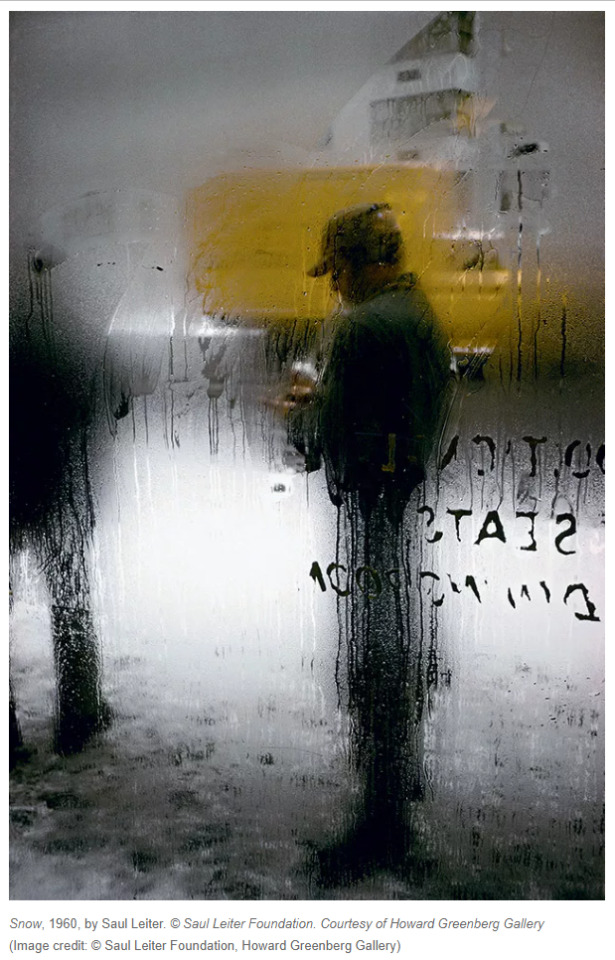
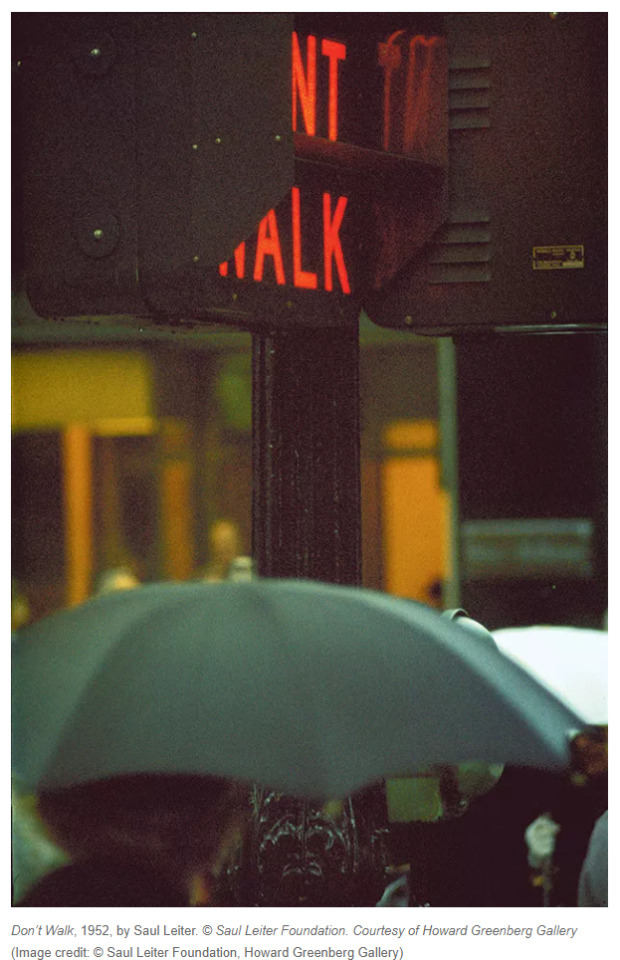

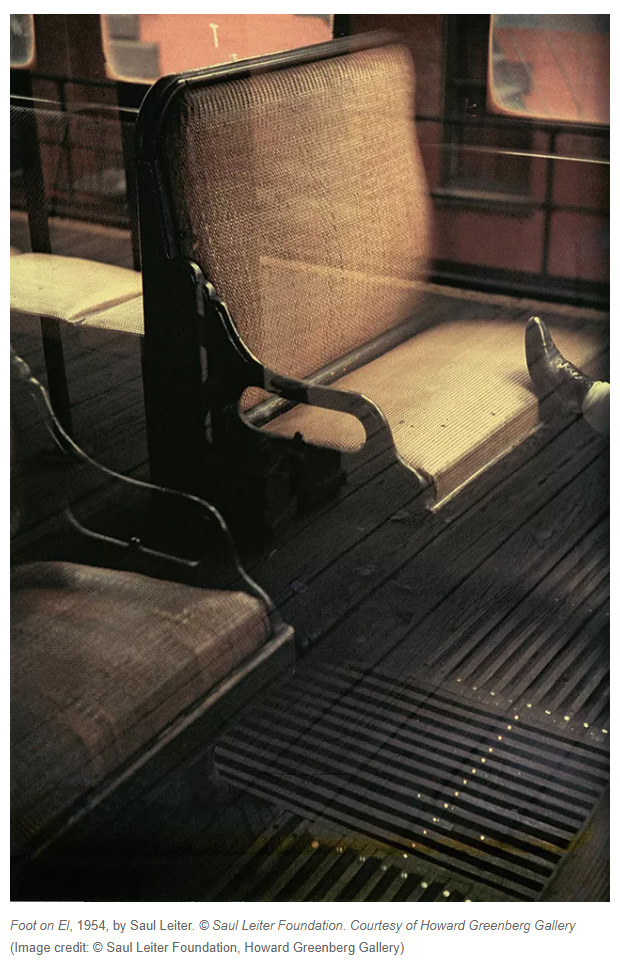
#Not preaching#just looking#not preaching just looking#saul leiter#art photography#photography#zen#zen photography
2 notes
·
View notes